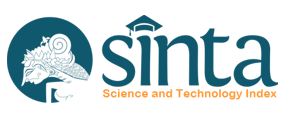DOES IT PAY TO BE TECHNICALLY EFFICIENT? EFFICIENCY AND PROFITABILITY IN INDONESIAN ISLAMIC RURAL BANKS WITH CONTROL VARIABLE MACRO ECONOMICS AND BANK CHARACTERISTICS
Abstract
BPRS is part of the banking system which has become large enough for Indonesia's economy, which tend to have more actively market their products in traditional markets or in the village, from the results of these remittances bank profit or advantage. With pengefektifan in gathering together and channelling of funds then it will get the maximum profit. Therefore this research aims to analyze the effect of efficiency and profitability of the BPRS in Indonesia. This research analysis tools using a Random Effect Regression (GLS) and use the data panel the secondary data obtained from Bank Indonesia audit of financial reports to see the big profitability is influenced by efficiency. This research uses elements of the crosssectional reflected by different banks in Indonesia and time series element reflected in the period in the period 2010-2016 in Indonesia. The findings in this study said that influential positive Efficiency significantly to the level of profitability of the BPRS in Indonesia.
Keywords
Full Text:
PDFReferences
Akhtar, H. M. (2002). X-Efficiency Analysis of Commercial Bank in Pakistan: A Preliminary Investigator. Pakistan Development Review 41(4): 567-580
Asutay, Mehmet. Izhar H. (2007). Estimating the Profitability of Islamic Banking: Evidence from Bank Muamalat Indonesia. Review of Islamic Economics. Vol. 11, No. 2, pp. 17-29, 2007.
Bader, Khaled. I. M. (2008). Cost, Revenue, and Profit Efficiency of Islamic Versus Conventional Banks: International Evidence Using Data Evelopment Analysis. Islamic Economic Studies. Vol.15, No.2, 2008
Berger, A.N. and L.J. Mester. 1997. Inside The Black Box: What Explains Differences In The Efficiencies of Financial Institutions?. Journal of Banking & Finance, 21, 895-947.
Coelli, Tim, Estache, Antonio.,Parelman, Sergio., & Trujilo, Lourdes (2003). A Primer on Efficiency Measurment for Utilities and Transport Regulators. WBI Development Studies, February 2003.
Dimitrova, Galina. (2005). Efficiency and Profitability of the Host Banking Sector. Austrian National Bank Jubilaeumsfonds’ Project. N 11753/2005 of the Economic Policy Institute 170-210
Firdaus, M. F. dan Hosen, M. N. (2013) Efisiensi Bank Umum Syariah Menggunakan Pendekatan Two Stage Data Envelopment Analysis. Buletin Ekonomi Moneter dan Perbankan. Vol. 16 No.2. 71-95
Košak, M. Zajc, P. 2006. Determinants of bank efficiency differences in the new EU member countries. Financial Stability Report, Expert Papers. Ljubljana: Bank of Slovenia.
Kosmidou, K. 2008, The Determinants of Banks’ Profits and Margins in Greece during the period of EU financial integration. Managerial Finance, vol. 34, no. 3, pp. 146–159.
Kosmidou, K., Tanna, S., Pasiouras, F. (2008). Determinants of profitability of domestic UK
commercial banks: panel evidence from the period 1995-2002. Economics, finance and accounting applied research working paper series no. RP08- 4. Coventry: Coventry University.
Limpaphayon, piman, dan siraphat polwitoon (2004) Bank Relationship And Firm Performance: Evidence From Thailand Before The Asian Financial Crisis. Journal of Business Finance And Accounting”
Miyajima, H., Y. Omi and N. Saito (2003) “Corporate Governance and Performance in Twentieth Century Japan” Business and Economic History Vol. 1, 1-36 Nawari. 2010. Analisis Regresi dengan MS Excel 2007 dan SPSS 17. Jakarta : PT.
Elex Media Komputindo.Penerbit Gava Media. Yogyakarta.
Nugraha, B.W. 2013. Analisis Efisiensi Perbankan Menggunakan Metode Non Parametrik Data Envelopment Analysis (DEA). Jurnal Ilmu Management Vol. 1
No. 1. 272-284
Palečková, I. 2015. Estimation of banking efficiency determinants in the Czech
Republic. Journal of Applied Economic Sciences, vol. 10, no. 2, pp. 234–242. Sufian, F. dan Chong, R.R. 2008. Determinant Of Bank Profitability In a Developing Economic: Empirical Evidence From the Philippines. Asian Academy of
Management Journal of Accounting and Finance, Vol.4, No. 2. 91-112
Wahab. (2015). Analisis Faktor-Faktor yang mempengaruhi Efisiensi Bank Umum Syariah di Indonesia Dengan Pendekatan Two Stage Stochastic Frontier Approach (Studi Analisis di Bank Umum Syariah). Economica: Jurnal Ekonomi
Islam. Vol. VI, Edisi 2, 2015. 57-76
Warnida, T.D. dan Hosen, M.N. 2015. Mapping and Correlation Analysis of
Efficiency and Profitability : The Case Of Islamic Rural Bank In Indonesia. Al-
Iqtishad: Vol. VII No. 1
Wartono, Tri. 2018. Pengaruh Current Ratio (CR) dan Debt to Equity Ratio (DER)
terhadap Return on Asset (ROA), Jurnal KREATIF : Pemasaran, Sumberdaya Manusia dan Keuangan, Vol.6 No. 2 April 2018. ISSN: 2339-0689, E-ISSN : 2406-8616.
Yuniarti, Sari. (2008). Kinerja Efisiensi Bank berstratifikasi sesuai dengan visi arsitektur perbankan indonesia. Journal of Finance and Banking. Vol. 12, No. 3 (2008). 459-478.
DOI: https://doi.org/10.32507/ajei.v13i1.1023
Refbacks
- There are currently no refbacks.
Copyright (c) 2022 Febrian Wahyu Wibowo
Indexed by:
© Copyright CC BY-SA Al-Infaq: Jurnal Ekonomi Islam, p-ISSN: 2087-2178, e-ISSN: 2579-6453 |






.png)